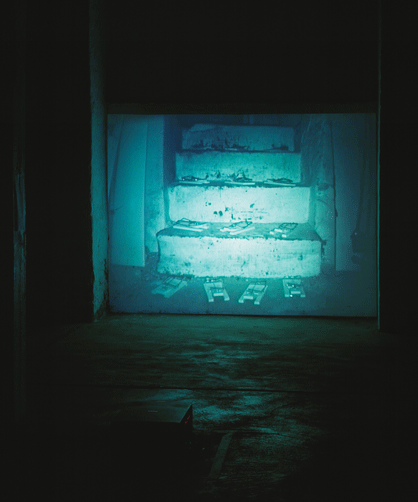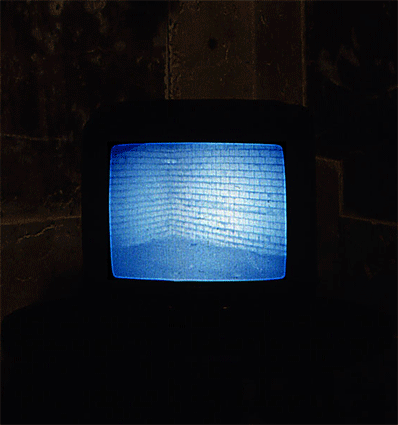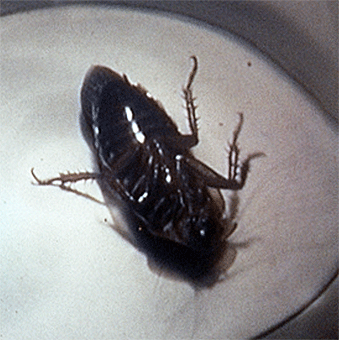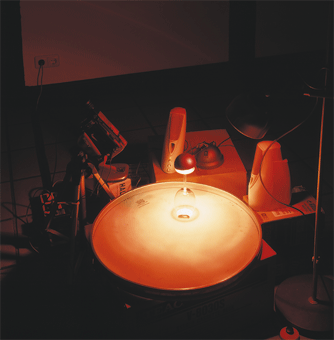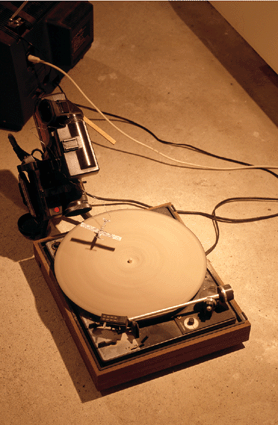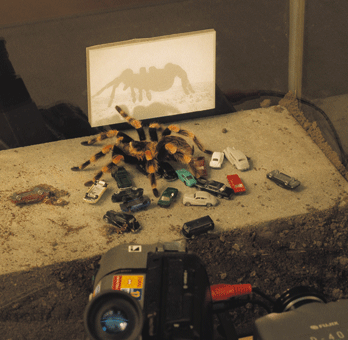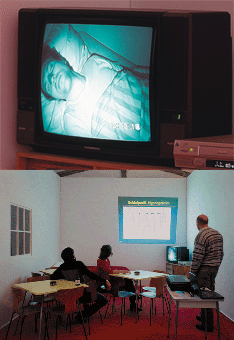All under controll?
Thoughts about the installation works by video artist Alexander Steig"Hit me with your rhythm stick" Ian Dury
rat trap, Foro Artistico, International Media-Art Forum, HannoverI. Guidelines
Alexander Steig's art work does not necessarily fit the steril, bright white cube of the established art scene. His work loves, although in an almost shy manner, the dark site of things. And it accepts the well known guidelines of the white cube - the aesthetized work of artifact caught in the "white cell"1 - making a clean separation between life and art, which this work, clearly in a way, does not. Rather this art happens in the glamorous spheres of Hollywood and those of the natural sciences, it occurs in the world of ubiquitous surveillance systems, and at the same time in the world of competitive sports… Steig's work takes place in the pubic sphere - e.g. at night in the Hanover train station2 or a mausoleum at the cemetery3 - as often it does in galleries or art establishments. But we shall see.
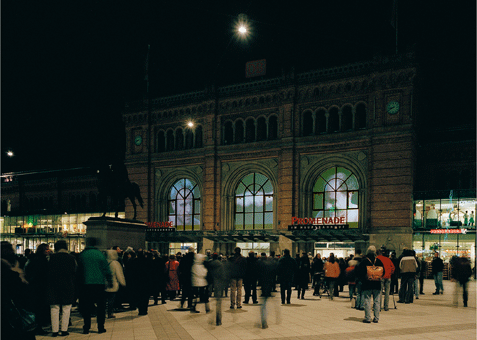
Fingerhakeln, 2001, Central station, Hannover
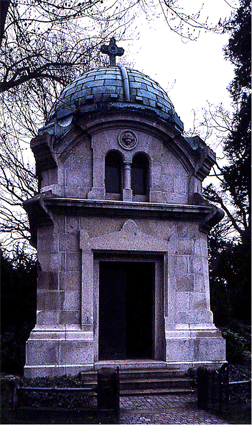
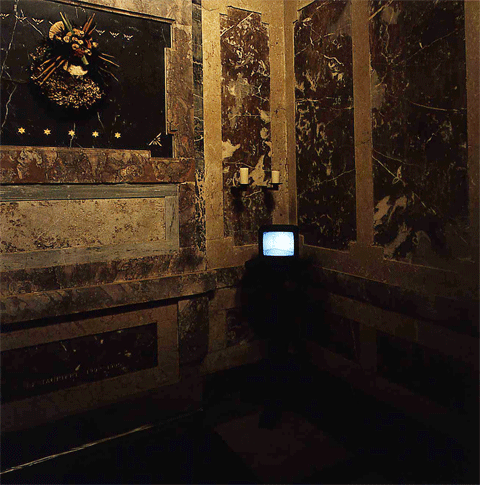
Über-Wachen, 1999, Engesohde Cemetery, HannoverII. On view
Let's have a closer look at Alexander Steig's installation work "La Cucaracha", 2001. A casted cockroach, selected by the artist at a previous video performance4, was placed under a wine glass on top of a drum skin. This peculiar set at the Kunstverein Wunstorf was lit by a white spotlight as well as a heating lamp. Beside this strange experiment a pair of speakers were placed from which the South American song "La Cucaracha" was heard on eternal replay. If it wanted to, the selected cockroach could start to dance to the song. In any case, this scenario, to be exact: the visual section which focused on the insect moving on top the drum skin was monitored by a video camera. On a TV screen nearly 10 meters away from the set up, visitors of the exhibition could watch the image - the enlarged representation of the dancing cockroach - at ease. At the same time any movement made by the "single dancer" was perceived by means of an amplifier. Finally, through headphones, the ear catcher "La Cucaracha" and the steps of the animal could be listened to: This time without noise disturbance from the exhibition area. Merciless surveillance and pleasurable entertainment, as well as scientific research and voyeuristic observation, altogether all takes place in this installation work, an by the end any of these moments, so it proves, intersects with the other.

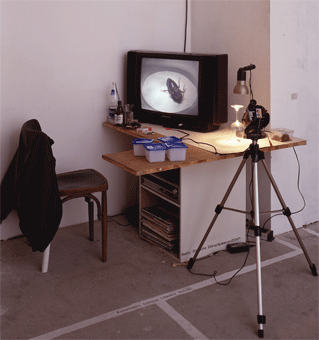
Casting, 2001, DEKP, Hannover
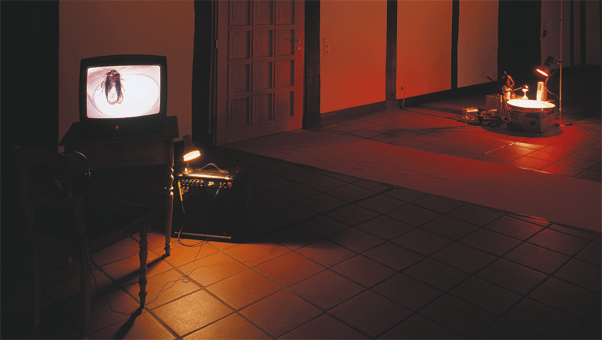
La Cucaracha, 2001, Kunstverein WunstorfIII. Video killed the reality star
The literary work by J G. Ballard - he was known to a wider audience most recently through David Cronenberg's film adaptation of "Crash" in 1996 - is among other things permeated with the ominous as well as inciting dialectics of subjective submission and medial control. It seems, thinking of the worldwide successful TV show "Big Brother", as if there were a desire for surveillance. Lust and suffering, increasingly exaggerated, become inseparable: the glance of a strager versus one's own perception no longer create opposites5. Especially in his narrative "Running Wild"6 does the American cult author describe the effects that total media control and the apparent dependence on the control system will cause on intelligence with as special twist: The internalisation of the all controlling equalization7 - in "Running Wild" introduced as modern video surveillance of a newly build luxurious residential estate - will lead in the fiction to a furious obliteration of the external world The world as will an imagination.

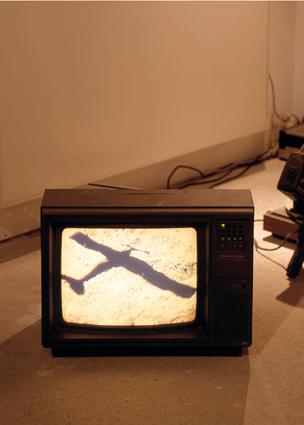
flying, 2000, Eine Deutsche Einkaufspassage, HannoverIV. Just like flying
A sandy desert landscape is apparently and seemingly real to watch on TV monitor. Also seen the silhouette of an airplane flying over the desert. But a quick glance to the side is revealing: it is Alexander Steig's installation "flying", 2000, a turning record player whose turntable is pilled up with dust from the gallery space. A small paper-maché airplane is positioned above the video camera which is set on a permanent record. A light source throws the shadow of the miniature plane on the dust.The external world reveals itself as fake (optical illusions), a hand-made construction designed to mislead - instead, its two dimensional representation comes across on the monitor as something real, exciting and entertaining. By means of his installation piece "flying", the artist presents us with a false world, thereby using as well as revealing its rules at the same time.
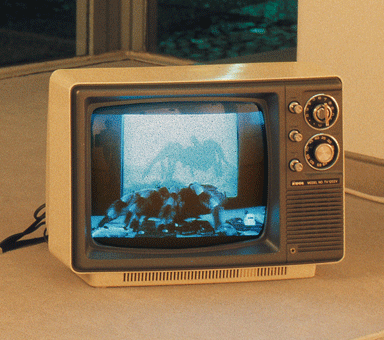
One Spider Show, 1999, NORD/LB-Art, HannoverV. Lust for power?
As in generally known Michel Foucault -among other tings in his work "Discipline and Punish: The Birth of the Prison" precisely describes the change from a disciplinary to a control society. This change is on the one hand linked to the primacy of the visual, the "all-is-visible" so to speak, but also, on the other hand, to a lustful permeation of socially relevant power and the individual body:" The reason for this, that power rules, that one accepts it, simply lies in the circumstance that it doesn't burden us by denying power but in truth permeates the bodies, producing things, creating lust, revealing knowledge, producing discourse; one needs to understand it as a productive network which covers the whole social body and not any longer as negative authority whose only function lies within a mode of suppression"8. And here again we reach the previously discussed state of entertainment that we enjoy over and over again through Alexander Steig's work "La Cucaracha"9.
...
Arbeitsraum (sleeping/working), 2000, Art IG, HannoverVI. Good Night
The everyday quality of surveillance (ÜberWACHen), as described by Michel Foucault, takes on an integral part of Alexander Steig's "well rested" video scenario "Arbeitsraum (sleeping/working)", 2000. In a special build room-within-room set up. Steig stayed overnight and videotaped his sleep. At one end of the bed stood a TV monitor on which to watch the monitored sleeper. Cool, an almost exhibitionistic self-representation and hereby indiscreet modes of control are changing hand. By the way: this installation was the discussing area of social scientist Edgar Zakaria. He gave a lecture about "Productive Value of Short and Superficial Sleeping Phases During Working Hours".Raimar Stange
Translation: Petra Klusmeyer, Bremen
1 Read: Brian O'Doherty, Inside the White Cube, edition Berlin 1996
2 Alexander Steig's video triptych/installation "Fingerhakeln", 2001, was shown in three large windows at the front side of the train station. The tug-of-warfight lasted 6:19 minutes and ended in a draw.
3 In the video work "Über-Wachen", 1999, a video camera with a video-light was installed in the vault of a mausoleum. An area of the vault was broadcasted to a small monitor placed in the room of devotion above.
4 "Casting", 2001, video performance at the DEKP Kunstraum, Hannover
5 Laura Mulvey in her most important (feminist)essay "Visual And Other Pleasures", edition Stuttgart, 1988, describes in relation to "Three Contributions to The Theory of Sex" by Sigmund Freud, that the development of sexuality depends on the (own) voyeuristic glance (in the mirror).
6 J.G. Ballard, Running Wild, New York 1989
7 See the works by American artist Julia Scher, e.g. on her website www.scherware.com and www.insecuritybyjulia.com, or look at: Woman Artists, Köln 2001, 476 ff.
8 Michel Foucault, The Order of Things, edition Berlin 1978, p. 35
9 In the video installation "rat trap", 2000, the entertainment quality takes on sadistic characteristics since as the viewer was able to live on screen how a rat would be killed by one of the installed traps. The work had to be deinstalled. With his work "One Spider Show", 1999/2000, the artist refers to the grizzly entertainment of the film classic "Tarantula", Jack Arnold, 1955, with the help of a living tarantula.(Catalogue Alexander Steig - Videoinstallation, Community of Stuhr, 2002)
